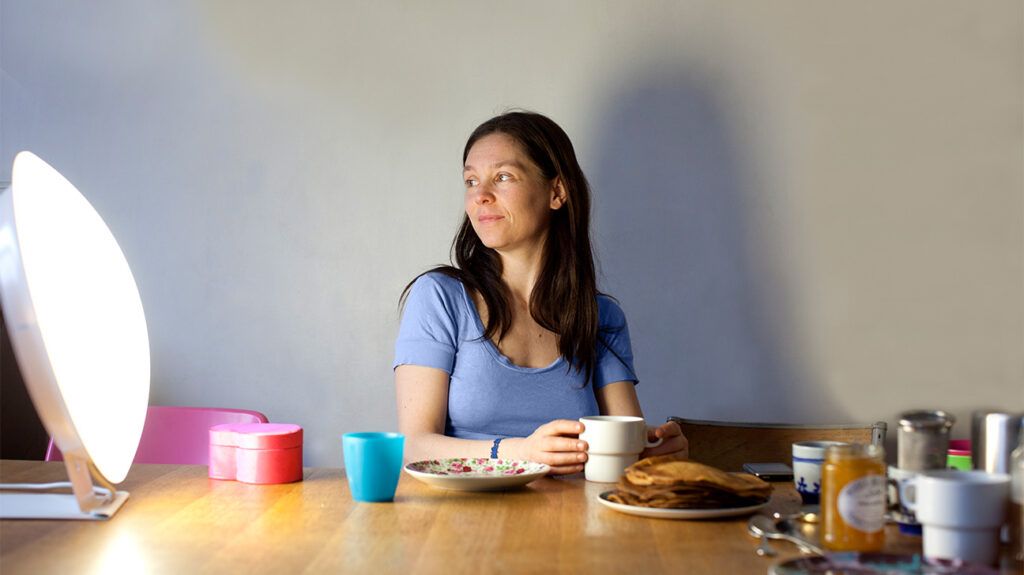Phototherapy is a treatment option for the seasonal depression that people may experience during winter. It involves using a special lamp to simulate sunlight that is typically missing in the darker winter months.
Seasonal depression, also known as major depressive disorder with a seasonal pattern, is a type of depression that occurs seasonally. It was previously known as seasonal affective disorder (SAD). People may refer to it as winter depression since it is usually more apparent and severe during the winter months. However, it can also occur in the summer.
Phototherapy, or light therapy, is a treatment option that uses certain types of light. For winter-pattern seasonal depression, light therapy treatment involves exposure to an artificial light source that mimics sunlight, which may help reduce symptoms of depression.

Light therapy is a medical treatment that involves exposure to certain wavelengths of light. Typically, a person will sit in front of a device called a light box, which emits a very bright light, for 30 minutes or longer every morning. Some devices with a less powerful light may require longer exposure.
To use a light box, a person can place the device in front of them or slightly off to the side. They should not look directly at the light but should keep their eyes open while using it. A person can carry on with their usual activities, such as eating, reading, or working, while they are using the light.
People
Health experts believe that light therapy works to treat winter-pattern seasonal depression because the light can help regulate various functions in the body. Notably, a 2024 research review suggests that light therapy can reduce symptoms of winter-pattern seasonal depression by:
- regulating a person’s circadian rhythms (also known as their biological clock)
- improving sleep quality
- reducing stress
The United Kingdom’s National Health Service (NHS) notes that light therapy may help reduce the production of melatonin, a hormone that makes people sleepy, and increase the production of serotonin, a hormone that regulates mood. However, more research is still necessary to determine how effective light therapy is for seasonal depression.
Because light boxes are not regulated, it is advisable to follow the recommendations of the Center for Environmental Therapeutics when buying a light box. A suitable light box should:
- have an intensity of 10,000 lux illuminance
- have a screen larger than 200 square inches
- have a screen that filters UV rays
- project downward toward the eyes
Light therapy has been a treatment option for winter-pattern seasonal depression since the
A 2019 review highlights that light therapy can be an effective stand-alone treatment for seasonal depression. The authors also state that people can use it alongside other treatments, such as medication, and that light therapy may be beneficial for other mood disorders.
According to Harvard Medical School, light therapy might be a suitable alternative to medication for people who need to avoid or limit the use of medications, including pregnant people and older adults.
Although light therapy can be an effective and generally safe treatment, it may not be suitable for everyone. For example, it may not be advisable for those with eye conditions such as:
Additionally, light therapy may not be suitable for people who are photosensitive, which means they experience an unusual reaction to light. This may include people with conditions such as photosensitive dermatitis or systemic lupus erythematosus. Certain medications, including some antibiotics, can also cause skin sensitivity to light.
It is advisable that a person discuss phototherapy with a doctor before trying it.
In rare cases, some people may experience the following side effects:
- eyestrain
- headaches
- blurry vision
- irritability
- difficulty sleeping, if using light therapy in the evening
- tiredness
- nausea
These side effects may occur at the beginning of treatment and will typically improve within a few days. If symptoms do not resolve, a person can try reducing their daily exposure time or sitting slightly farther away from the light box. If the symptoms still do not go away, a person might consider stopping the treatment and consulting a doctor.
While evidence suggests that light therapy can be effective for seasonal depression, more research is still necessary to determine the optimal illumination and duration of use.
Light boxes can also be expensive, and insurance may not cover the cost of a light box, even if a person’s doctor has prescribed it.
Aside from light therapy, treatment options for seasonal depression
- psychotherapy
- antidepressants
- vitamin D supplements
Both light therapy and vitamin D supplements are options to help treat winter-pattern seasonal depression specifically. Psychotherapy and antidepressants can be beneficial for treating any type of depression.
Light therapy is a treatment that involves exposure to bright light. Many healthcare professionals consider it the first-line treatment for winter-pattern seasonal depression, which is a type of depression that occurs during the winter months.
Research suggests that this therapy mimics natural sunlight, which is usually less abundant in the darker winter months. Light therapy may help relieve symptoms of depression, such as low mood and sleep problems, by regulating various processes in the body.

